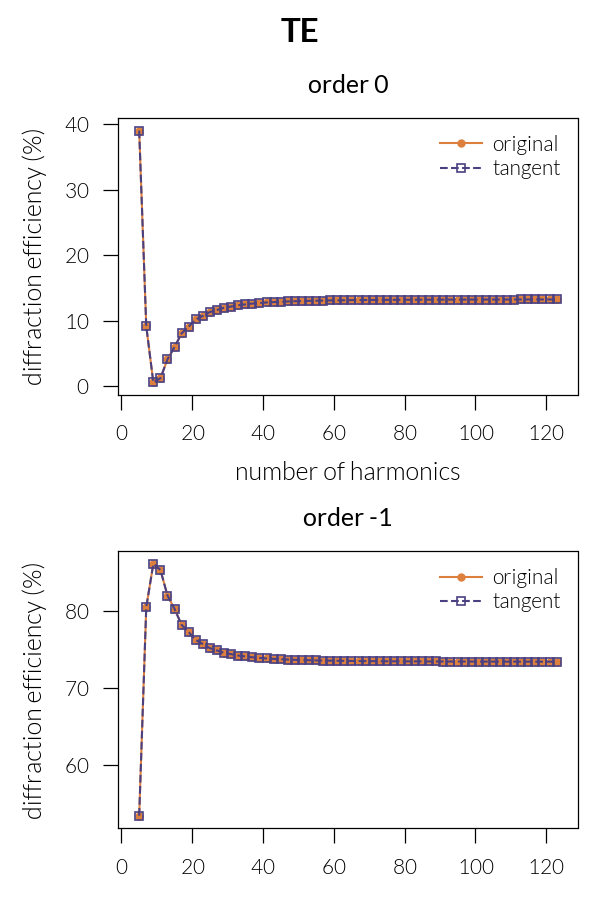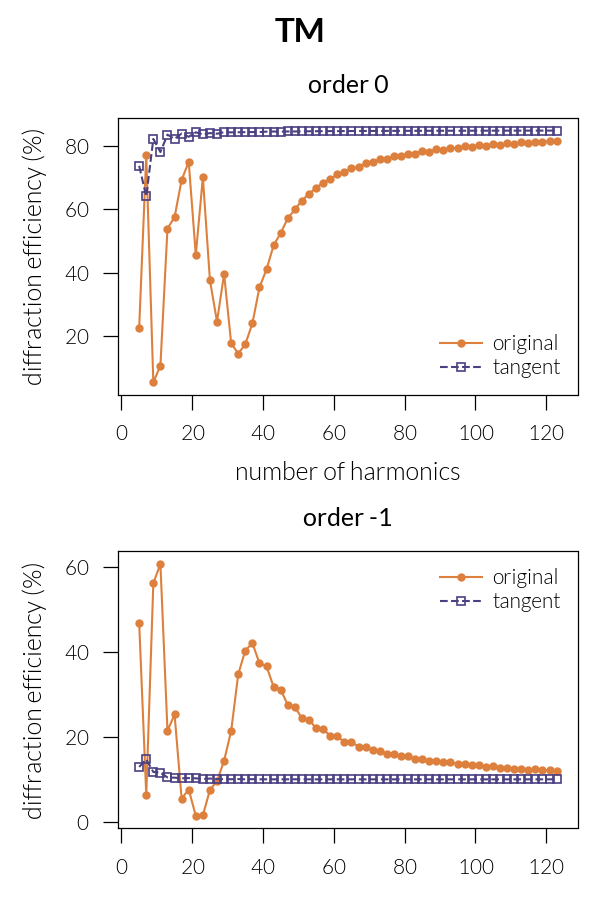Note
Go to the end to download the full example code. or to run this example in your browser via Binder
One dimensional grating#
Convergence.
import matplotlib.pyplot as plt
import numpy as np
import nannos as nn
We will study the 1D metallic grating as in [Li1993].
def convergence_study(form, psi, Nh):
ts0 = []
tsm1 = []
ns = []
for nh in Nh:
lattice = nn.Lattice(1, 2**9)
eps_metal = (0.22 + 6.71j) ** 2
epsgrid = lattice.ones() * 1
hole = lattice.stripe(0.5, 0.5)
epsgrid[hole] = eps_metal
sup = lattice.Layer("Superstrate")
sub = lattice.Layer("Substrate", epsilon=eps_metal)
grating = lattice.Layer("Grating", thickness=1)
grating.epsilon = epsgrid
stack = [sup, grating, sub]
pw = nn.PlaneWave(wavelength=1, angles=(30, 0, psi))
sim = nn.Simulation(stack, pw, nh, formulation=form)
R, T = sim.diffraction_efficiencies()
Ri, Ti = sim.diffraction_efficiencies(orders=True)
R0 = sim.get_order(Ri, 0)
Rm1 = sim.get_order(Ri, -1)
ts0.append(R0)
tsm1.append(Rm1)
ns.append(sim.nh)
return np.array(ns), 100 * np.array(ts0), 100 * np.array(tsm1)
def run(psi):
Nh = range(5, 125, 2)
fig, ax = plt.subplots(2, 1, figsize=(2.0, 3.0))
title = "TM" if psi == 0 else "TE"
ns, ts0, tsm1 = convergence_study("original", psi, Nh)
ax[0].plot(ns, ts0, "-o", label="original", c="#dd803d", ms=1)
ax[1].plot(ns, tsm1, "-o", label="original", c="#dd803d", ms=1)
ns_tan, ts0_tan, tsm1_tan = convergence_study("tangent", psi, Nh)
ax[0].plot(
ns_tan, ts0_tan, "--s", label="tangent", c="#4a4082", ms=2, mew=0.4, mfc="None"
)
ax[1].plot(
ns_tan, tsm1_tan, "--s", label="tangent", c="#4a4082", ms=2, mew=0.4, mfc="None"
)
ax[0].set_title("order 0")
ax[1].set_title("order -1")
ax[0].legend()
ax[1].legend()
ax[0].set_xlabel("number of harmonics")
ax[0].set_ylabel("diffraction efficiency (%)")
ax[1].set_ylabel("diffraction efficiency (%)")
plt.suptitle(title, weight="bold", size=8)
plt.tight_layout()
plt.pause(0.1)
For TE polarization the two formulations are equivalent:
run(psi=90)

We can see that in TM polarization, the convergence is greatly
improved by using proper Fourier factorization rules implemented by the
tangent formulation.
run(psi=0)

Total running time of the script: (0 minutes 22.387 seconds)
Estimated memory usage: 756 MB

